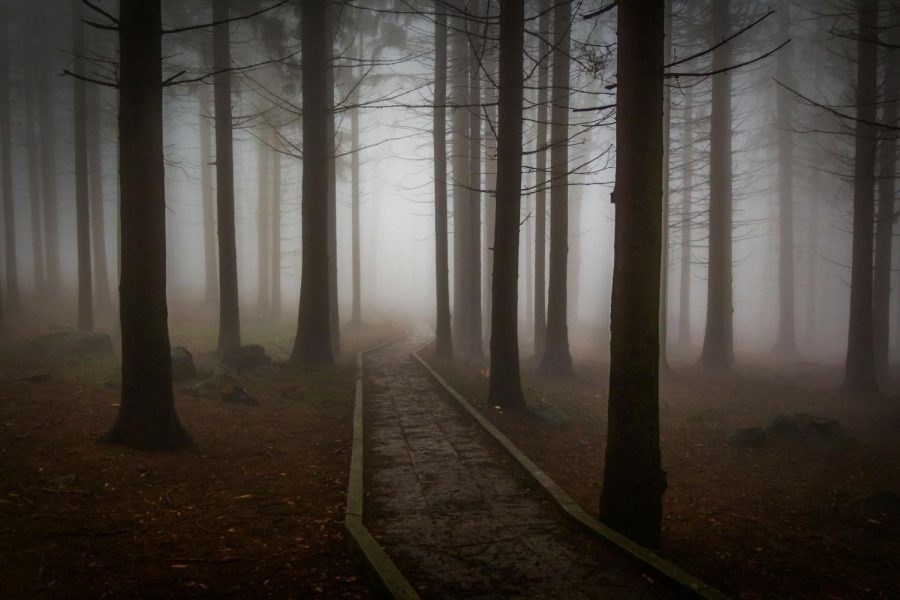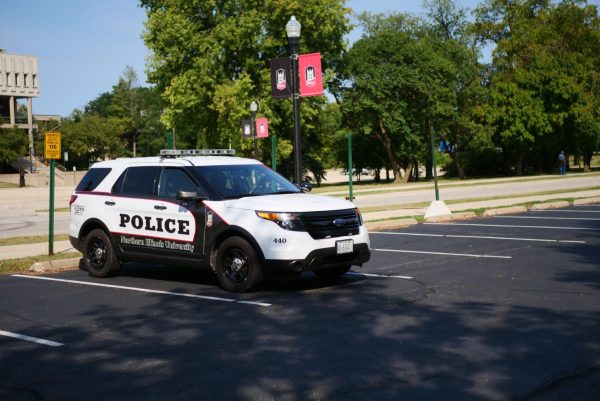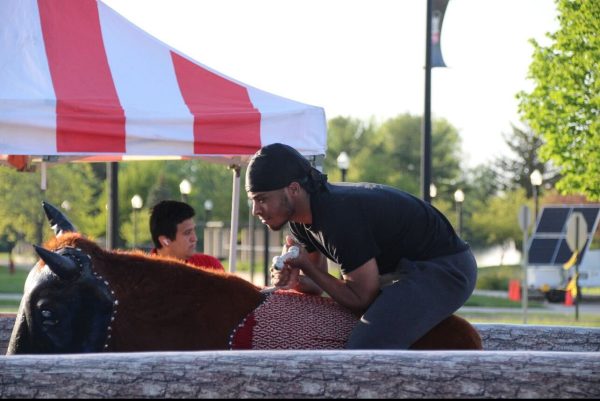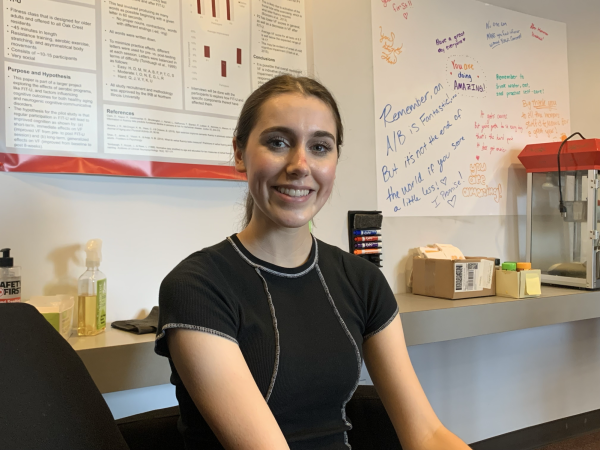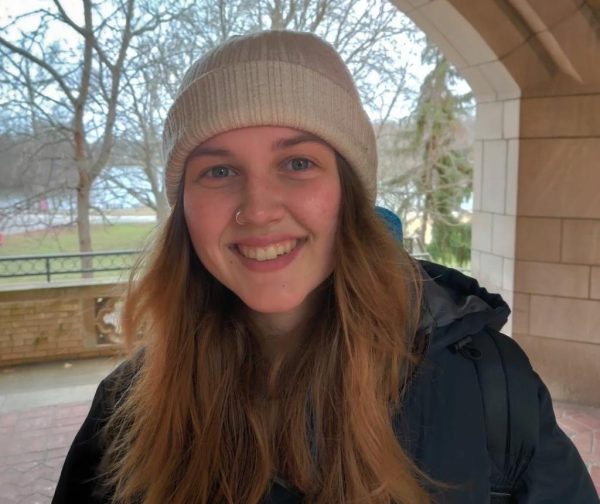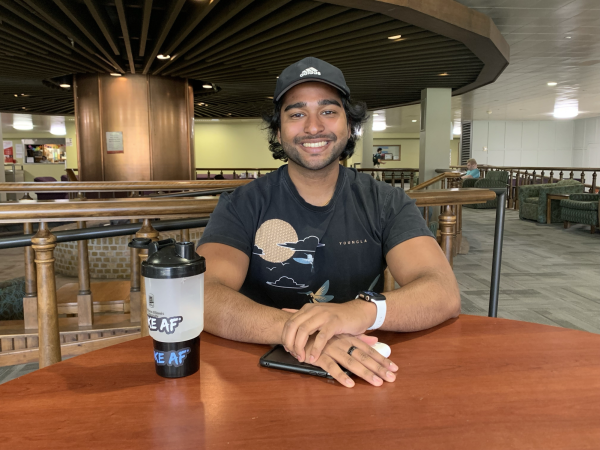Halloween: A journey into the DeKalb-Sycamore Order of Odd Fellows
October 31, 2019
DeKALB — In an unsuspecting residential neighborhood, just past downtown Sycamore, stands a structure that separates itself from the rest of the small-scale, average homes on the block. It’s a minimal, off-white brick house with two tiny glass-block windows. Its black front door has a three-link chain on its cold, otherwise blank face.
This chain is the emblem of the Independent Order of Odd Fellows, a fraternity founded in 1819 in Baltimore, Maryland, by English philanthropist Thomas Wildey, for which this simple structure serves as a lodge. This structure also happens to be haunted, at least according to Mark Schwabe, a member of the IOOF who investigates the paranormal with an organization called Ghost Head Soup, a nod to the Rolling Stones’ 1973 studio album.
“This closet’s creepy,” uttered Schwabe, as he enters a closet in the nearly blackened upstairs space of the building. “These books up here, these are old minute books, dating back all the way pre-Civil War.” He proceeds to pull a giant leather-bound book from the shelf, its stained pages adorned with tiny rips along the edges. It contains the minutes of IOOF meetings at the lodge and what was discussed at those meetings, Schwabe explained.
The upstairs space, referred to as “the lab,” is occupied by an abundance of chairs neatly positioned along all sides of the room. They’re where Ghost Head Soup members sit while detecting the sensations of ghostly activity. One of these chairs is a detailed relic, carved from wood with an hourglass symbol; a shepherd’s crook and lyre both lean up beside it. Ritualistic robes dating back more than a century dangle from the walls.
“We’re Masonic in nature,” Schwabe continued. “The Odd Fellows is an organization; we’re benevolent, we help our community. We used to run orphanages back in the day.” The IOOF’s mission, found on its website, says one of its purposes is: “To improve and elevate the character of mankind by promoting the principles of friendship, love, truth, faith, hope, charity and universal justice.”
A Van de Graaff generator continually pops and crackles in the corner of the room closest to the door used to enter the space. “The theory is that spirits draw off energy,” said Schwabe, elaborating on the generator’s purpose. “The Van de Graaff is actually creating energy, so maybe they feed off it.”
Schwabe traced the IOOF’s long local history. He said Alonzo Ellwood belonged to the original Sycamore lodge in the 1800s. Alonzo Ellwood was the older brother of Isaac L. Ellwood, who was a famous developer of barbed wire in DeKalb.
Isaac L. Ellwood once lived in a Victorian mansion, referred to as the Ellwood House, in central DeKalb, which now serves as a historical museum. According to the museum’s website, three generations of Ellwoods lived there from 1879 to 1965. It’s also said to be haunted, as a web page linked to the DeKalb County Ghost Society lays out a story shared by DeKalb historian Steve Bigolin. In his story, Bigolin claims a friend of his once brought a woman to the mansion and she witnessed the apparition of a deceased member of the Ellwood family.
Bigolin works in the local history room at the DeKalb Public Library. It’s in this room where he clarified specific details of the story, his impression of it and his own connection to the Ellwood House. He recalled another friend of his, the sister-in-law of the man from the other story, who would experience a “cold chill” whenever she entered the library inside the mansion. “She didn’t say, per se, that she saw any kind of apparitions or felt any other presence,” he explained. “[She] wondered, ‘Did anything out of the ordinary ever happen in that room that might account for it?’” Indeed, Bigolin claims he later discovered that Perry Ellwood, Isaac’s son, had his funeral in that room in January 1943.
The confusion of the other story, as told on the DCGS website, lies in the passage where the woman identifies the ghost. As it is told, the woman had no idea who the person she saw in a Victorian dress in the glass conservatory was until she saw a portrait of that person hanging in a hallway inside the mansion. This person is identified in the story as “Ann Ellwood,” who never actually existed.
This nugget of misinformation is part of what led DeKalb resident Kendall Hampton, an intern at the Ellwood House Museum, to dismiss the story as bogus. “If I had a nickel for every time someone asked me, ‘So is this place haunted?’ I’d be rich,” she chuckled, while giving a tour of the historic mansion. “Fortunately, it’s not haunted,” she continued. “[The story] doesn’t add up.”
Bigolin cleared up that the “ghost” in the story was actually meant to be that of May Ellwood, who was Perry’s wife. He also claimed, on a separate occasion, that this story took place sometime around 1977 and 1978, briefly after he had met his friend who brought the woman to the Ellwood House. The way he tells it, his friend and the woman guest had separated on the grounds outside the house, as it was closed that day. It wasn’t until weeks later that the two of them had entered and the woman was able to identify May Ellwood in the portrait.
When the matter of whether Bigolin believed the woman’s ghost-sighting was raised, he paused, exhaled and said, “Hard to say.” After another pause, he continued, “I just took what she told me as the truth.” He adds that for as long as he’s been going to the mansion, since 1972, he personally has never encountered anything explicitly paranormal.
Sometime after the tour of the “lab,” in the downstairs lounge of the IOOF lodge, Ghost Head Soup member Dean Thompson is sitting behind a laptop, zooming in on a ketchup packet with a microscope camera. Meanwhile, Schwabe is discussing his own experience that led him to believe the lodge is haunted.
“I started coming [to the lodge] around 2000 or 2001,” he recalled. “[The other members] had asked me to close the door at the end of the night, lock the door. I went upstairs, up in the foyer by the front door, locked it, and then all of a sudden somebody was right behind me. My hair stood up. It was like I almost heard him. … And I ran down those steps, ran in here and I said, ‘This effing place is haunted.’” Eventually, Ghost Head Soup was formed after members started investigating the lodge as a result of their own spooky encounters.
They use a variety of equipment to detect the presence of spirits, in addition to attracting them via a Van de Graaff generator. Schwabe made note of the importance of simple audio recorders and night-vision cameras before turning his attention to what he and the crew call the “Ghost Box,” which is a handheld radio frequency scanner with the antenna removed.
Tim Schmuldt, another Ghost Head Soup member, was busy setting one up while Schwabe explained what it does. “[Schmuldt] will hook up a recorder to it,” he said. “We’ll ask questions and all of a sudden he’ll just say stuff he hears on the box.” Schmuldt turned the gray box around to reveal the climbing digits, indicating an increase in frequency.
The group meets on the last Tuesday of every month. According to its website, it has investigated two local museums: The Aurora Regional Fire Museum and the Tinker Swiss Cottage in Rockford. Noticeably absent from the list is the Ellwood House, which Hampton confirmed is because the museum contains much of the original furniture used by the Ellwoods, and the staff do everything in their power to preserve its condition.
However, Thompson left open the possibility of the Ellwood House being haunted, since it’s meant to appear as close to how it once did when the Ellwoods still lived there. “If you go into an old home, especially museums, and they have the original pieces that came with that house, I mean that’s how it was and everything,” he explained. “And you could go in there every day of the week and not feel a thing. All of a sudden, [spirits] appear out of nowhere and they start talking to you.”
Hampton, on the other hand, is not so optimistic about that possibility, as she believes there are more reasonable explanations for what people often attribute to ghosts and that there should be a science behind ghost detection for it to attain legitimacy. “My experience with ghost hunting is, obviously, the shows that they put out, which are very [dramatized]” she said. “They’ll play a clip of some audio they caught and it’s absolute gibberish, and they’ll say this is what they said exactly.”
Thompson had this to say about whether there’s a science to detecting ghosts: “We’re still data collecting.” Melissa Johnson, another member of Ghost Head Soup, said their work is meant to lay the foundation for future scientific frameworks. Thompson continues by predicting, “They’ll take all our evidence and say, ‘OK,’ throw it in a giant computer, … let it quantify everything that we have [and] figure it out.”



